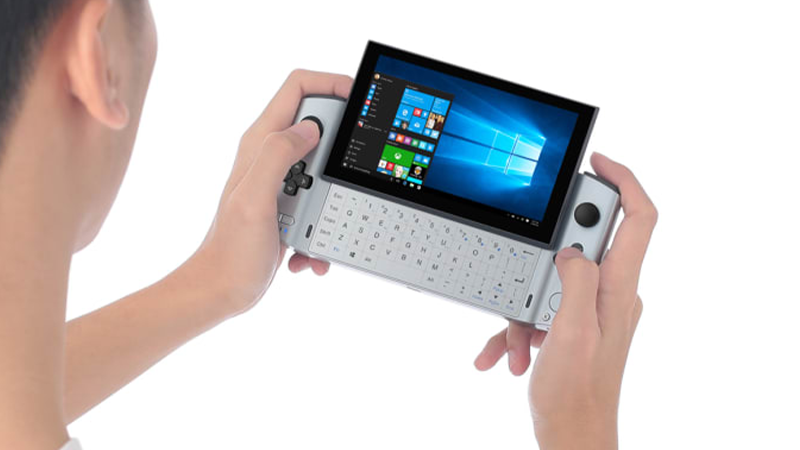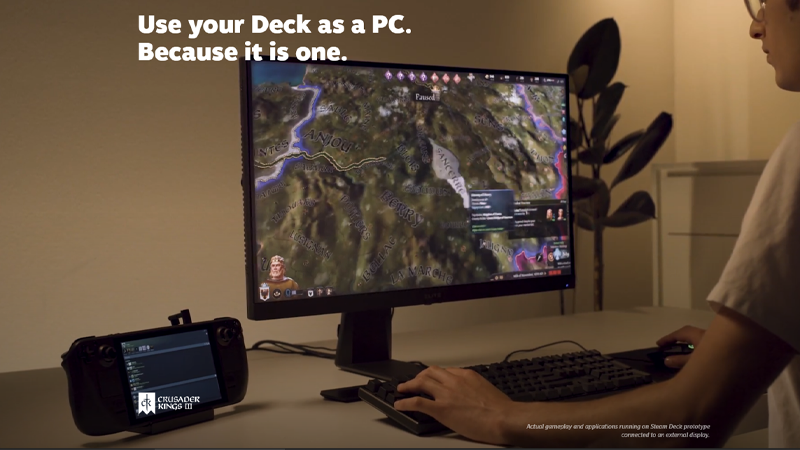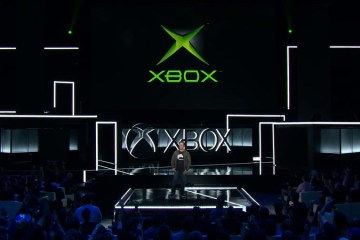People were once up in arms about the recent revelation that Valve’s upcoming handheld gaming PC (titled the Steam Deck) will be aiming to run games 30 Frames Per Second (FPS). Like a busy city airport, folks are announcing the cancellations of their pre-orders. While the device, whose price ranges from $400 to $650 USD, have received quite the backlash from gaming enthusiasts, there happens to be several elements alluding to the reason why performance is deemed “underwhelming.” While people tend to compare the Steam Deck to the Nintendo Switch, I implore people to turn their heads to a different breed of handled market.
Comparing the vast capabilities of the Steam Deck to the Nintendo Switch can be a bit disingenuous to a degree due to control style, connectivity, and the massive number of games in the backlog that we will never play. Not to also mention that the price point of the Nintendo Switch seems to be a bit more affordable for families and has brand renown thanks to Mario, Pokémon, and The Legend of Zelda. It is generally a more family-focused device that parents tend to not have a problem buying due to Nintendo’s rich history.
Handheld gaming PCs have grown but remain unfamiliar to the current mass market, with many devices relying on crowd-funding campaigns to even consider manufacturing. It’s been a niche concept that has slowly come to fruition within the last several years. As we are clashing with the immense popularity and continuous rise of the mobile gaming market, it only makes sense for companies to try to indirectly compete in that area. Instead of having watered-down version of titles like Call of Duty, Valve is attempting to bring quality to consumers with little cost of entry. Combining the backlog of the Steam library in a mobile form-factor is a win no matter how you look at it. For daily commuters like me, this could be a device that sets a new precedent for future hybrid technologies, almost positioning itself as the new focal point of modern gaming experiences. I know, bold words.

As I mentioned, the Steam Deck is not the only device on the market, the Gamepad Digital (on GPD.hk) offers a wide range of devices that are focused on mobile PC gaming as well as emulation. Their most affordable device at a price point of $245.49 USD is the GPD XD Plus which is designed for emulating PlayStation, PSP, DS, and many more systems, making this ideal for the retro gamer. Fair to say that the specs of the device are low, equipped with an MT8176 ARM processor (found in tablets and mobile devices), 4GB of LPDDR3 RAM, and integrated graphics. This device is aimed for a specific goal, and on paper, performance seems to track to it.
GPD’s Win3 is reminiscent of the old T-Mobile Sidekick, sporting joysticks, face buttons, and a sliding screen that reveals a miniature keyboard. An Intel Core i5, 16GB LPDDR4x 4266 MHz RAM, 1TB storage drive, and Intel Iris Xe Graphics, this machine is said to perform up to 60fps on a 1280 x 720 screen. Integrated graphics not being a choice option for gaming, on paper (once again) , this device seems to deliver a sense of performance that could work but I don’t expect us to play any resource-demanding games on it. Direct pricing from GPD’s website tells me the cost goes to a max of $1,230.25 USD, while other sources state $799 for a standard edition and $899 for an advanced edition that gives you an Intel i7 CPU which enhances the integrated graphics.

Another handheld PC device called the Aya Neo is planned to hit the market after a successful crowdsourcing campaign on Indiegogo. An AMD Ryzen 5 4500U processor, 16GB LPDDR4x 4266 MHz RAM, and M.2 NVMe SSD storage (with 512GB and 1TB available) are all present on the Aya Neo. While this isn’t out in the wild just yet, the device does seem promising until you look at the price of entry of around $700. Although it does seem to include the docking station as per their funding page.
When you look at these devices such as the GPD Win3 and compare it to the Steam Deck, the price really stands out. With cost being the first thing average consumers look at, it can be relatively easy to price yourself out of the market. If price wasn’t a concern, then companies like Sony and Microsoft wouldn’t consider releasing variations of their more powerful or robust consoles. Lower price-points enables companies to leverage themselves into consumer households much easier. When it comes to business decisions, you’re not making choices, you’re making compromises, and Sony, Microsoft, and Nintendo have all displayed that. At the same time, the Aya Neo and Win3 are aimed towards PC gamers who are already accustomed to expensive hardware.

This brings us to the Steam Deck. Each model has the same base components with storage being the only variable. 2.4 GHz AMD Zen 2 CPU, 16GB LPDDR5 RAM, and an RDNA-based graphics act as the powerhouse to the device. Storage is where performance will also vary, with 64GB eMMC memory only acting on PCIe Gen 2 x1 connectivity compared to the 256GB and 512GB NVMe PCIe Gen 3 x4 interface. I feel like I need to reiterate that Valve stated that the Steam Deck can perform up to 30fps despite the 1280 x 800 resolution display having the ability to produce up to 60fps, but that is due to the nuances of production standards. Integrated graphics are still present here, and I don’t think we are going to stray too far from the concept.
When you really start looking at each component the pieces of the puzzle should start to make sense. I briefly mentioned compromises and Valve had their own here as well. A low resolution screen means the integrated graphics should work a bit smoother with a lower frame rate, which should equal lower thermal performance. PCIe NVMe storage is pricey, but it loads games quicker and gives that feeling of a true powerful handheld. Without having my own hands-on experience with any of these devices, I can only go based on specs, and no matter what processor a device has, I can only assume that 30fps at 720 resolution is going to be the common standard for the handheld market.
PC desktop and (some) laptop gaming setups have the capabilities to hit up to 120fps depending on what components you have. Console gaming has been able to hit 120fps as of recently with select titles as well. Games like Sony’s exclusive Spider-Man franchise and Ubisoft’s WatchDogs: Legion offer graphical options, allowing you to embrace smooth 60fps fidelity or ray tracing capabilities with a reduced 30fps rate.
According to Global News Wire, an NVIDIA press release from June 1st, 2021, states that 130 titles are currently support ray tracing and NVIDIA’s Deep Learning Super Sampling (DLSS) technologies. Consoles might be using AMD-based technologies, but NVIDIA seems to have a grasp on the PC market despite their latest release (and shortage) of their 30 series graphics cards which support these technologies. In an odd sense, the technology that drives PC market ends up in the console realm eventually, as we have seen. These high-end technologies are incredibly hard to transition into a mobile form factor that is attempting to remain as compact, lightweight, and convenient.

Fighting and complaining about 30fps on a handheld console is not the hill to die on. Technology is evolving but there are roadblocks on almost every avenue that would keep us from making a portable Xbox Series X, hence why Microsoft is opting for cloud-based gaming. While fear, uncertainty, and doubt begin to flood the social media streams, we must keep in mind the technological evolution of our portable devices. We must temper our expectations and have a firm understanding of the power that allows these devices to thrive, especially in a mobile market.
People are treating the Steam Deck like a device midway through a technological cycle where the form factor has been perfected, and we are far from it. While other devices are paving the way, Steam Deck is looking to reset the race and set a precedent that doesn’t rely on the whims of gamers with an easy grand to spend. The entry point for mobile PC gaming with Steam Deck is $400, and yes, there are caveats to that that price point, but this is the start.
As I have said before, Steam Deck melds your precious backlog with a mobile form factor that will deliver what I believe to be a suitable experience for gaming enthusiasts on the go. Based on hardware alone, there is no legitimate reason for me to expect over-the-top performance, and I think expecting more than that is unreasonable. If this news breaks your support, then that is fine. It is your money, spend it as you wish. If you already have a powerful desktop, I can’t see any real reason to own this device. Personally, I look forward to playing my backlog during my daily commutes come this December.



[…] approach with simplified abilities (seems almost perfect for a controller or the upcoming Steam Deck). Weapon-focused upgrade paths that make you feel as if you are excelling at something by allowing […]